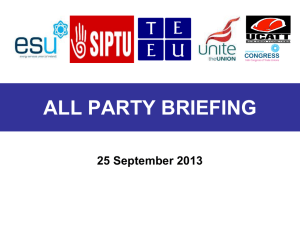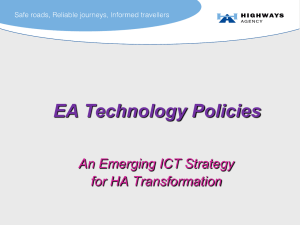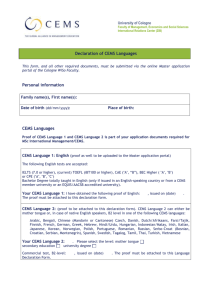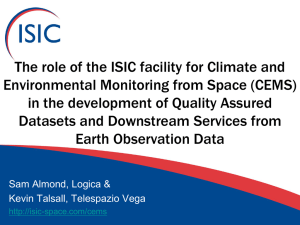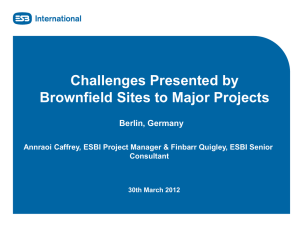now
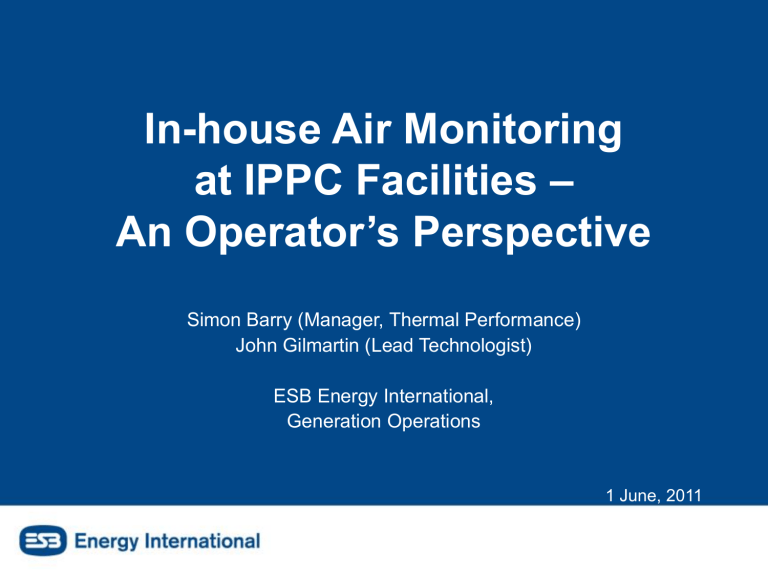
In-house Air Monitoring at IPPC Facilities –
An Operator’s Perspective
Simon Barry (Manager, Thermal Performance)
John Gilmartin (Lead Technologist)
ESB Energy International,
Generation Operations
1 June, 2011
Agenda
• Background & History of ESB Air Monitoring
• CEMS Management
• Quality Air Monitoring
• Typical Work & Practicalities
• ISO 17025
ESB Thermal Generation Portfolio
• 7 Thermal Sites
• Capacity
~2850MW
• Range of
Technologies
• Fuels
– Gas
– Coal
– Peat
– HFO
– Gas Oil
Moneypoint
Coal / HFO
PF
West Offaly Power
Peat / Biomass
Fluidised Bed
Lough Ree Power
Peat / Biomass
Fluidised Bed
Aghada
Gas / Gas oil
CCGT / OCGT / Thermal
Marina
Gas / Gas oil
OCGT
North Wall
Gas / Gas oil
CCGT / OCGT
Poolbeg
Gas / Gas oil
CCGT
ESB Air Monitoring Background
• ESB Test & Efficiency Department
• Since 1960’s – Flue gas testing for thermal plant
• Early 90’s – NO
X emissions (Moneypoint low NO
• Late 90’s – CEMS installation (Opsis) & testing
X
)
• 2005 ~ Now – EN14181 compliance
• 2006 – VGB Emissions Monitoring Working Group
• Current team (Thermal Performance) – 3 persons
ESB, Quality & EN14181
• EN14181:2004 Stationary Source Emissions – Quality
Assurance of Automated Monitoring Systems
• CEMS Quality Assurance Development
• 2004: Monitoring compliance for LCPD & EN14181
• 2005 – EN14181 planning & implementation
• 2006 – VGB European Working Group on EN14181
• 2006 – Marina QAL2 (first ESB EN14181 test)
• 2006~2007 – EPA AG3 steering group
• Members of Source Testing Association
• Interface to VGB / EOn / EDF
CEMS Management
• Local Management
• ISO14001 Certification
• Central Support Functions
– Environmental
– Testing / Thermal
Performance
• Expertise increases CEMS
– Quality
– Availability
– Reliability
Station
Environmental
Coordinator
Environmental
Management
System
Station
EI&C
Technicians
Central
In-house
Testing
CEMS
Work
Management
System
Central
Expert
Functions
OEM
Service
& Parts
CEMS Quality Assurance
EN14956 EN14181 EN14181
Manufacturer Operator / Test House Operator / Test House
ESB Air Monitoring Quality Assurance
Objective
Reporting
Equipment
• Certification
• Calibration
• Traceability
Methods & Procedures
• Standard Reference Methods
Quality
Competence & Training
(MCERT’s)
Internal Auditing
Typical ESB Air Monitoring Work
• Plant Emissions Validation & Acceptance Testing
• CEMS Cross Checks
• Abatement Plant Optimisation
• Thermal Performance Optimisation
• EN14181 Compliance
– QAL2
– Annual Surveillance Tests
• Other
– CEMS Expert Advice & Troubleshooting
– Witness CEMS Acceptance Testing
Testing Equipment
• Range of Species Monitored for Compliance
– NO & NO
2
– SO
2
– CO / CO
2
– Particulates
• Equipment
– Extractive Heated Line
– Chiller Dryer
– Horiba PG250 & Eco-Physics
– Tecora Iso-kinetic & Gravimat
– Electrochemical (MRU)
• Certified Calibration Gases (UKAS)
Emissions Testing – Amorebieta, Spain
Moneypoint MERP Acceptance Testing
Witness & Test Coordination
Moneypoint Environmental Retrofit Project
EN14181 Compliance
Aghada CCGT
Lough Ree Power
Poolbeg CCGT
Some Technical Challenges…
• UKAS Certified Calibration Gases
• NO
X
Converter Efficiency > 95%
• Blocked Heated Lines & Probes
• QAL3 Process Automation
• Plant Dispatch
Practicalities – Getting the Test Done
• Plant Dispatch by Eirgrid National Control Centre
• National electric demand = supply in real time
• Wide variability in dispatch, difficult to predict (wind generation)
• Specific load @ specific times = difficult!
• In-house test team = flexible
• Flexibility to react to plant dispatch reduces :
– Environmental impact
– Test cost ( €€€ )
Practicalities – Plant Dispatch
Dispatch effects test window
Quality management
• Quality Management System (e.g. ISO 17025)
• ESB has Quality Management:
– Significant Experience & Competence
– Certified Equipment & Reference Materials
– Calibration & Testing Procedures
– Auditing
– External Training & Certification (UK MCERTs)
– Reporting
Difficulties with ISO 17025 Implementation
• Thermal Performance – small team (3)
• Significant workload in setting up for ISO 17025
• Additional workload in managing ISO 17025 QMS
• Resources & €€€!
• More suited to larger laboratory environment
• No economy of scale for ESB
• Decision – business case for accreditation?
Benefits of In-House Testing to ESB
• Expertise in business critical area
• Flexibility
• Ownership of issues
• Familiarity with installation & equipment
• Allows us to challenge manufacturers and 3 rd party tests
• Reduced
– Environmental impact
– Testing cost
• Focus
– getting job done right
– not quickly => quality benefits
• In house monitoring => best fit
Summary
• Background
• CEMS Management
• Quality Processes
• Typical Work & Challenges
• ISO 17025
• Benefits of In-house Monitoring to ESB
Questions & Answers
In-house Air Monitoring at IPPC Facilities -
An Operator’s Perspective
Simon Barry & John Gilmartin
ESB Thermal Performance simon.barry@esb.ie



